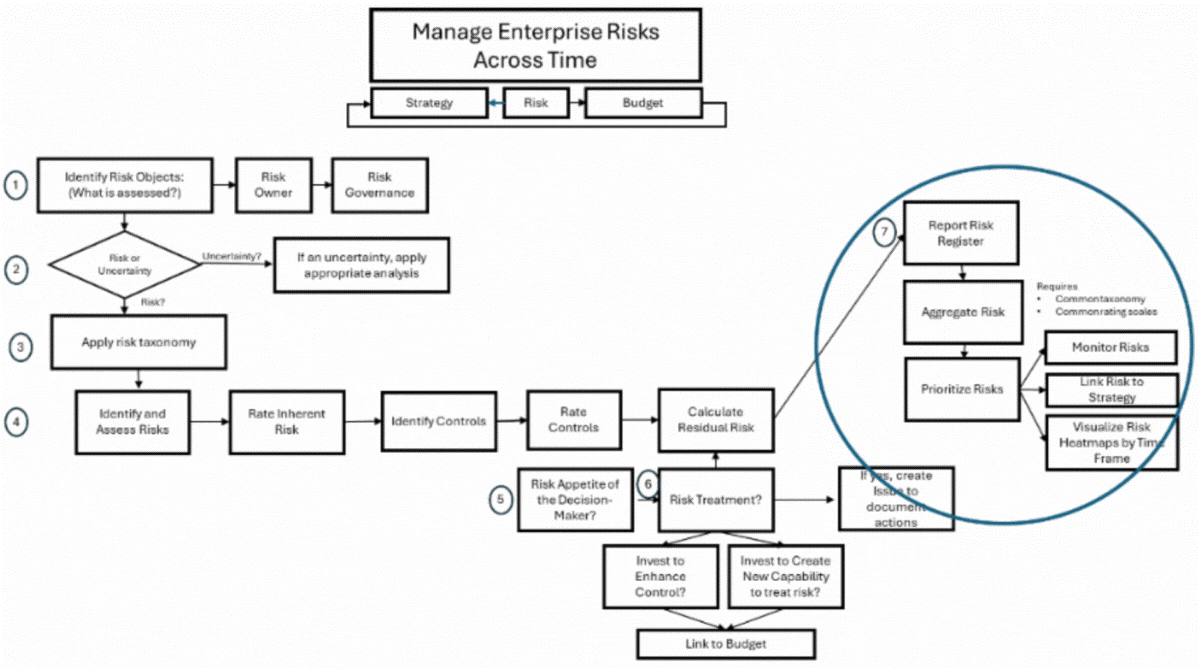
The aggregation, prioritization, and linkage of top risks to an organization’s strategy is critical in helping risk officers properly manage risk trade-offs and the efficient allocation of resources to achieve targeted risk levels. In order to do so, risk officers have to analyze a vast number of unique risk data points. These must be aggregated based on a common risk taxonomy and rating scales, prioritized based on risk ratings, and quantitatively simulated as risks or opportunities to the organization’s strategic objectives.
Risk aggregation and prioritization is the final step of an overall Enterprise Risk Management (ERM) Framework (Figure 1).
Figure 1: Enterprise Risk Management Framework

1. Establish a Comprehensive Risk Register
A risk register is a compilation of risk assessments across an organization, providing data management and drill-down capabilities.
A proper risk register should capture enterprise risks across the entire organization. This would include every type of risk in the organization, ranging from financial risk to attrition risk. Properly organizing these risks would be ineffective without a standardized risk taxonomy which enables an organization to effectively create a risk register that is consistent throughout.
Brenda Boultwood
The risk register will reflect standardized probability and impact risk rating scales based both inherent and residual risk levels.
Finally, this register must be malleable to constant updates and input of new risk assessment details in order to give the risk officer the most timely and relevant data. Having drill-down capabilities is important as well since it will allow a risk officer to assess risk at every level; for example, it can be viewed by risk type, organizational unit, geography, or for the entire organization. This comprehensive risk register creates the foundation for risk aggregation, prioritization, and linkage of risks to strategy.
2. Risk Aggregation
Risk aggregation is the summation of the risks in the risk register across an organization. Specifically, it involves evaluating risks in each organizational branch and in total. Risk aggregation creates a risk portfolio for the business and its risk officer, ensuring that risks are not just viewed as isolated occurrences.
Risk aggregation based on a common risk taxonomy and rating scales ensures consistency across an organization, and doing so enables leaders to assess and manage risk at every level.
3. Risk Prioritization
Risk prioritization is determined by evaluating the probability and impacts of risk where the highest-rated risks are considered the priority risks. Priority risks are not based on opinion or bias, but instead reflec objective probability and impact ratings. The linkage of risk will allow for informing decision-making about the most critical risks.
Matthew Wang
Prioritization allows risk officers to recommend resource allocations required to manage the risks based on their importance. There are several tools that risk officers can utilize to prioritize risk based on their needs.
Qualitative tools such as heat maps can be used to demonstrate relative risk priorities. A risk heat map employs colors to strengthen the risk visualization’s mental impression. Visualization methods can be augmented with quantitative tools based on mathematical models to compare risks more objectively.
An organization can use scenario analysis to determine how a risk plays out if it occurs. Building from this, risk officers could simulate possible risk combinations to prioritize the most likely outcomes, as well as those with the highest potential impact.
4. Link Priority Risks to Strategy
This final step ensures risk officers can embed risk awareness directly into better data-driven decision-making and effectively optimize the risk tradeoffs required to achieve an organization’s strategy.
After the successful implementation of risk aggregation and prioritization, a risk officer can link risk directly to the organization’s overall strategy. This will help to ensure the organization takes steps to efficiently allocate resources to achieve long-term success.
A risk officer can align the most critical risks to a strategic goal using visualization and quantitative methods. Priority risks can be linked to strategic objectives to enhance board and executive-management awareness of the potential losses as well as opportunities. The discission could lead to decisions about the adjustments – for example, to organization structure or incentives – that have the potential to make the opportunities more likely. This process has its challenges, as it is difficult to align long-term strategies with potential short-term risk. It is important to balance investments to treat risks with the ability to seize new opportunities to accelerate the overall strategy.
Parting Thoughts
The chief risk officer must always be prepared to discuss not only the most critical risks across the organization, but also how company resources have been efficiently allocated towards the treatment of risks and how resulting levels of residual risk impact the organization’s budget and ability to achieve strategy.
Through risk aggregation, prioritization, and linkage to strategy, risk officers can effectively organize, connect, and link risk to organizational objectives to facilitate strategic decision-making. Ultimately, this overall process will transform risk management into a forward-thinking strategic capability, one that pinpoints the critical risks most related to strategic objectives.
Brenda Boultwood is the Distinguished Visiting Professor, Admiral Crowe Chair, in the Economics Department at the United States Naval Academy. The views expressed in this article are her own and should not be attributed to the United States Naval Academy, the U.S. Navy or the U.S. Department of Defense.
She is the former Director of the Office of Risk Management at the International Monetary Fund. She has previously served as a board member at both the Committee of Chief Risk Officers (CCRO) and GARP, and is also the former senior vice president and chief risk officer at Constellation Energy. She held a variety of business, risk management, and compliance roles at JPMorgan Chase and Bank One.
Matthew Wang is an Ensign in the United States Navy who graduated in May 2025 from the United States Naval Academy. He played varsity squash all four years and was a three-time 1st-Team All-Conference player. He was a Mathematics with Economics major and commissioned as a United States Submarine officer.
Topics: Enterprise